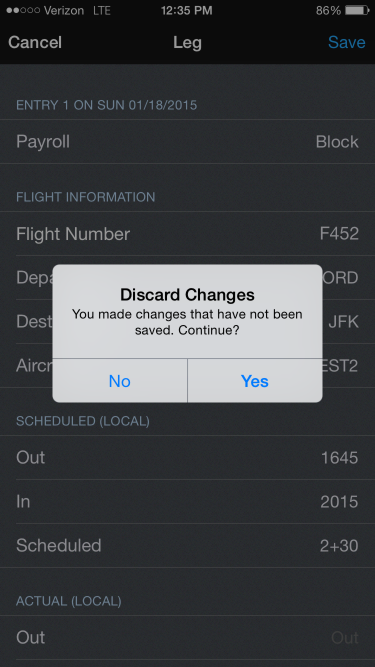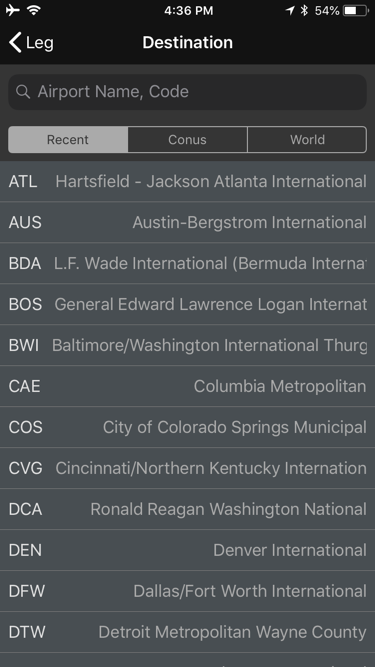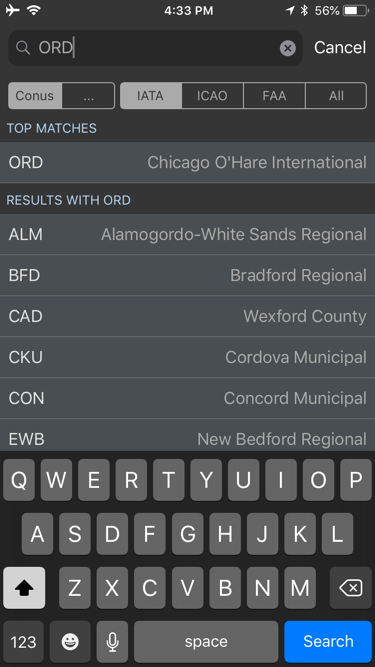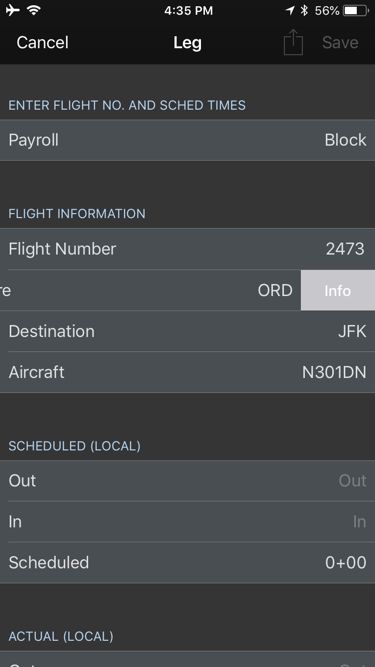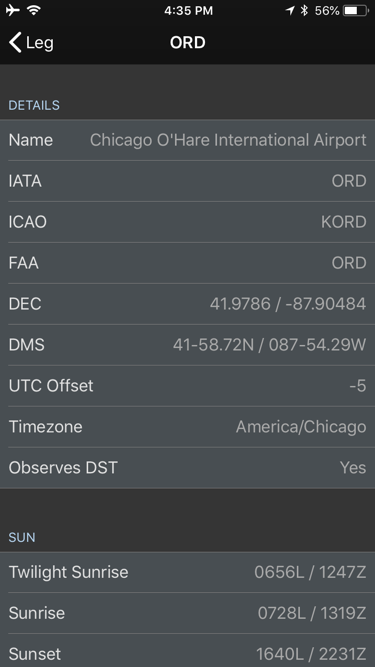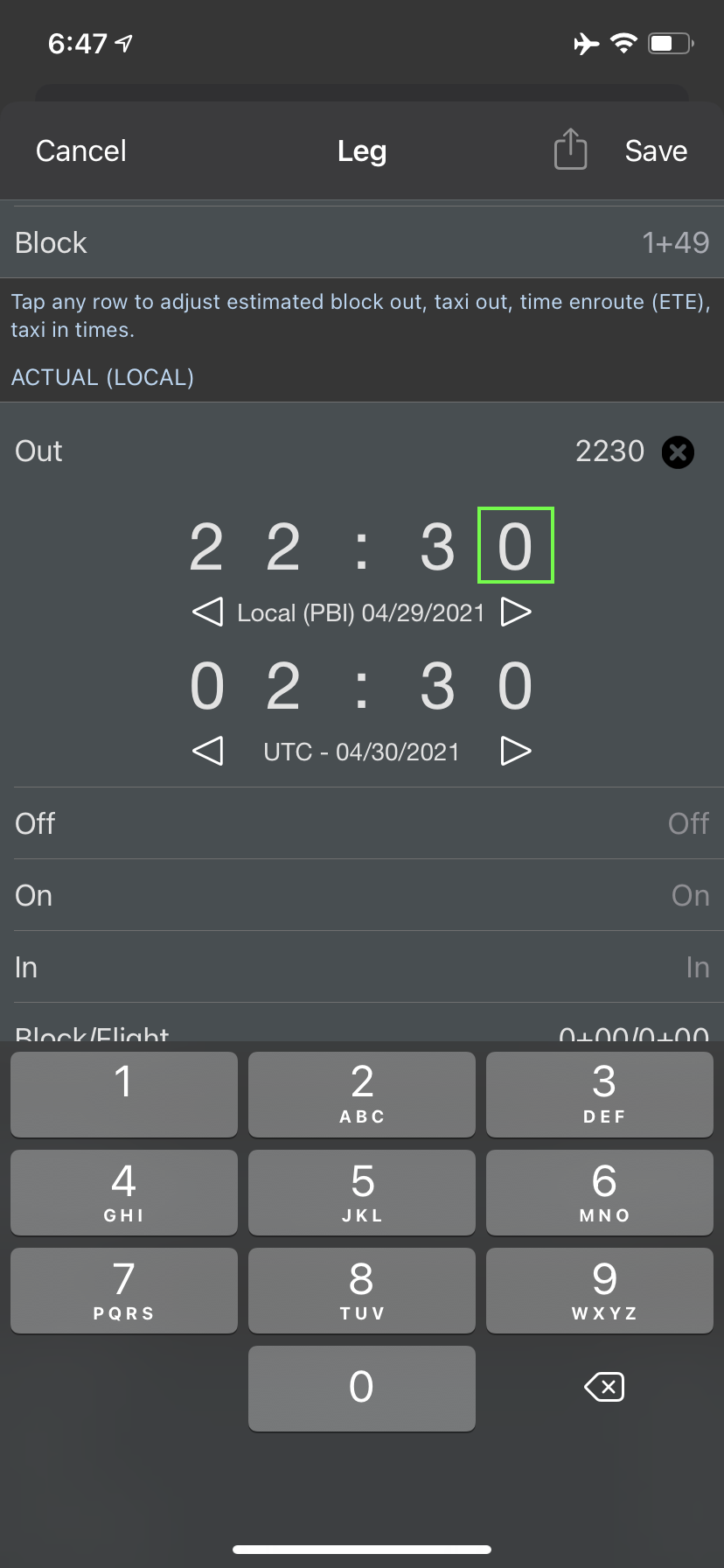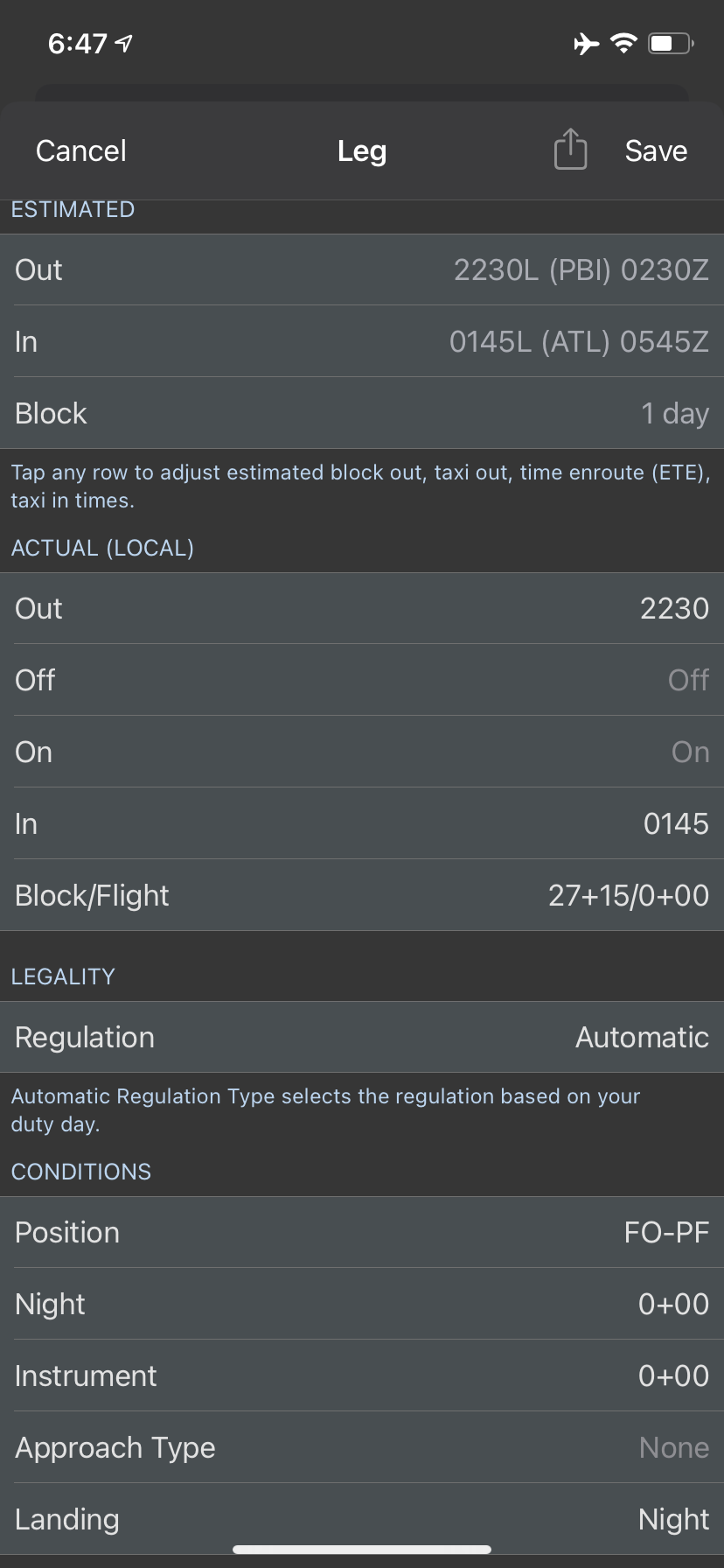...
If you open the Leg View for a preloaded flight, your preloaded data will be displayed. Since this is just scheduled data, some fields will be missing. Tap each field to update.
APDL uses pop up windows for entry views such as Leg View and the Duty Editor View. These can be dragged down slowly to peek at the page underneath, or flicked out of view to close.
Tapping the Save button at the top right of the window will save changes made on the Leg View and return to the previous view.
Tapping There are two ways to cancel changes. You can tap the Cancel button at the top left of the window will or flick the pop up out of view. Both of these methods will prompt you if changes have been made. If you select yes, changes made will be canceled and you will return to the previous view. If enabled in settings, you can skip this prompt. If no changes have been made, you will simply return to the previous view.
After the required data has been entered and saved, the leg will be closed out. Opening the Leg View for a closed out leg will display all the data in a read-only format. A locked out leg is indicated by a lock icon at the top right of the window where the Save button would be. Any attempts to edit data on a locked out leg will prompt you to unlock the leg by tapping the lock icon. After unlocking the leg, edits can be made again.
| Anchor | ||||
|---|---|---|---|---|
|
...
If you have a 3D Touch enabled device, you can force touch the payroll row to peek at the details of that payroll category. A harder press will allow you to pop into the Payroll Settings view to edit the details of that payroll category.
| Anchor | ||||
|---|---|---|---|---|
|
Flight number is a free form field for you to enter your flight number.
| Anchor | ||||
|---|---|---|---|---|
|
...
On the Trip View itself, if you have a 3D Touch enabled device, you can force press to peek at the details of your selected departure and destination airports, while a harder press or swipe left will allow you to pop to that page to edit that information. If you tap on the departure or destination airport to make a selection from the list of airports, you can force press to peek at the details of each airport in the list as well.
| Anchor | ||||
|---|---|---|---|---|
|
...
| Note |
|---|
AutoFill can only process flights within the past 7 days or upcoming 3 days. |
| Anchor | ||||
|---|---|---|---|---|
|
All time editors within APDL function the same, regardless of what page they are on. You will most commonly interact with them on the Leg View while entering OOOI times, and Trip View when entering duty times. There may be prefilled times in a time editor before you edit them. These prefilled times may come from your previously imported schedule, or an estimate APDL generates depending on your settings such as the time between duty on and the first scheduled departure time.
Typically, there will be more than one row to enter multiple times on each page. Tap each row to enter the associated time. Tapping a row will expand the view and display the time editor. The time zones used for the top and bottom rows of time editors will vary depending on your time zone selections in Settings > General. If you use the default settings, the top row will display local time and date for the departure or destination airport as appropriate. The bottom row will display UTC time and date. The green box indicates the digit that is currently being edited. You can tap any digit on the local or UTC row at any time to edit it. . On the Leg View there is a section for Scheduled and Actual times. Scheduled times should be preloaded automatically with the importer or manually. Actual times are entered when the flight is completed. Tap each row to enter the associated time. Tapping a row will expand the view and display the time editor. The time zones used for the top and bottom rows of time editors will vary depending on your time zone selections in Settings > Leg View. If you use the default settings, the top row will display local time and date for the departure or destination airport selected above as appropriate. The bottom row will display UTC time and date. The green box indicates the digit that is currently being edited. You can tap any digit on the local or UTC row at any time to edit it. Changing the "Enter Times In" setting in the Settings > Leg ViewSettings > General will set the green box to default to the local or UTC row as selected.
To clear an erroneous entry, tap the black "x" icon to the right of the active row.
...
The Scheduled and Block/Flight rows calculate and display the totals according to the times entered. Block is calculated from Out to In while Flight is calculated from Off to On.
...
Take note that each time you enter has a date associated with it (example below). This is important since flights often span multiple dates and time zones. APDL uses a smart algorithm to attempt to determine which date is appropriate for each time you have entered. This means that typically if you enter a high value Out or Off time, such as 2230, and then enter a lower value for the On or In time, such as 0145, APDL will expect that you intended that time to be on the following date, since you can't land before you takeoff. As you enter 0145 in the time editor, APDL will automatically advance the date forward by one. This usually goes unnoticed, so if you manually advance the date after APDL has advanced it, your flight entry will be incorrect and will span more than 24 hours.
Sometimes, however, APDL gets this calculation wrong and will advance the date when it doesn't need to be advanced. Usually this happens when you make a time entry incorrectly and then change that entry to a different value, such as accidentally entering 2100 when you meant to enter 0210. This could appear to APDL as if you've entered a high value time followed by a low value time, which can get the calculation out of sequence.
| Note | ||
|---|---|---|
| ||
It's very important to verify that the total duration of your entries looks accurate. If it doesn't look right, check the date of all of your times. Chances are that is where the issue may be. |
In the example below, 2230 has been entered as the Out time with a date of 4/29/2021. As soon as a 0 is entered for the first digit of the In time, APDL automatically advances the date of the In time to 4/30/2021. You can see in the "Block" line above, this results in a 4+00 duration. If the date is then manually advanced, without noticing that APDL did this automatically, the date changes to 5/1/2021 and the resulting flight duration (Block) is incorrect at greater than 1 day.
| Anchor | ||||
|---|---|---|---|---|
|
The Estimated Times section is between the Scheduled and Actual Times sections. If you anticipate a change in any of your scheduled times, such as a delay or wheels up time, you can enter those times into the Estimated Times section to have APDL update its calculations. This can be used to calculate a Latest Available Takeoff Time (LATT), give you an estimate of how the rest of the flight will be affected, as well as the remainder of your duty period.
Tap on any row in the Estimated Times section to go to the Estimated page and enter your estimates. More details on Estimated features can be found on the Estimated Page.
Additionally, if it is after your scheduled departure time and you have not entered an actual OUT time, APDL will assume that you are delayed and automatically enter projected mode. If APDL is in projected mode, the projected values for OUT and IN will be displayed in orange in the Estimated Times section.
| Anchor | ||||
|---|---|---|---|---|
|
The Taxi Time field allows you to use the FAR 1.1 definition of flight time to calculate your legalities in APDL if you choose. To use Taxi Time, enter the time your aircraft first taxied under its own power in the Taxi Time field. This is differentiated from "Block Out" which is typically pushback time. Entering a Taxi Time will use the FAR 1.1 definition of flight time for legality calculations on that leg. Otherwise, block time is used by default.
The Taxi Time field can be hidden from view by turning off "Enable Taxi Time" in Settings > General > Misc.
| Anchor | ||||
|---|---|---|---|---|
|
The regulation field allows you to select which type of regulation your flight falls under. This affects how APDL calculates your legality limits. Automatic selects the appropriate regulation based on your entire duty day. You can manually override the automatic selection if needed.
| Anchor | ||||
|---|---|---|---|---|
|
The position field allows you to specify your role during the flight. This selection determines if various things will be logged in your logbook such as landings and PIC. Specific settings can be configured in the settings area.
If you have a 3D Touch enabled device, you can force touch the position row to peek at the details of that position. A harder press will allow you to pop into the Position Settings view to edit the details of that position.
| Anchor | ||||
|---|---|---|---|---|
|
APDL automatically calculates night for you after times are entered based on your data and civil twilight times. Entering Off and On times enhances the accuracy of the auto night calculation. You can manually enter a night value here if you wish to do so. The blue text below the night time editor displays the calculated night time. Tapping this value will set night to the auto calculated time after making a manual entry. To clear the night entry tap the black "x" icon on the right side.
When specified by your settings for the currently selected Leg View (CA-PF or CA-PM), APDL automatically logs your landings as a day or night landing based on the time of the landing with reference to sunrise or sunset as appropriate at the destination airport. Prior to completing the flight, APDL will display either "Scheduled Day" or "Scheduled Night" to indicate what type of landing is anticipated for that flight.
| Note | ||
|---|---|---|
| ||
Due to the way night flight time versus night landings are determined according to FARs, it is possible for a flight to have some night time logged while a day landing is logged. For more details on how this can happen, see Why does my Flight have Night Time but no Night Landing? |
| Anchor | ||||
|---|---|---|---|---|
|
Manually enter your instrument time here if applicable. The blue text below the instrument time editor allows you to quickly enter the entire flight duration from Off to On as instrument time if desired.
| Anchor | ||||
|---|---|---|---|---|
|
Allows you to select the type of approach flown, if applicable.
| Anchor | ||||
|---|---|---|---|---|
|
APDL keeps a database of crewmembers you have entered. You can choose or search for a crewmember from the list for multiple positions of your flight crew. You can add new flight crewmembers from the settings area or from the Leg View by tapping the plus icon at the top right of the window. If more than two crewmembers are entered in the Pilots section, APDL will treat that flight as an Augmented operation with more than 2 pilots and use the appropriate regulations accordingly. Be sure if you enter flight attendants that they go into the Cabin Crew section so Augmented operations are not inadvertently triggered.
If you have designated a crewmember entry as you by selecting "This is Me" in the Settings > Crewmembers area, you can quickly select yourself by tapping the "Me" row at the top of the crewmembers list.
If you have a 3D Touch enabled device, you can force press to peek at the crewmembers selected for that flight, while a harder press will allow you to pop to that page to edit that information. The same is true on the subsequent page where you can force press to peek at the details for each specific crewmember. On a non 3D Touch enabled device, you can long press to get the peek effect described above. During this peek, a menu of options is displayed to allow you to edit that crewmember's details, select or deselect them for the applicable flight, or view a list of all flights with that crewmember.
| Anchor | ||||
|---|---|---|---|---|
|
| Scroll Ignore | ||||
|---|---|---|---|---|
|
https://www.youtube.com/watch?v=DSFwVfI3LMo&list=PLt5jhPpkokeL7jZrgoINs1synCP7F3iAy&index=13
The Rest Facility row displays the rest facility class selected for the leg you're viewing. This selection will be used in legality calculations for augmented operations.
APDL will fill in this row with the rest facility class according to the following:
- Default rest facility class for the aircraft type. You should set the default rest facility class for any aircraft types you fly which have rest facilities and are used in augmented operations. You can do this under Settings > Aircraft Types.
- Default rest facility class for this specific aircraft. If your airline has some specific aircraft configured differently than the majority of the fleet, the rest facility class may also be different. You can override the default rest facility class set for the aircraft type by setting a default rest facility for individual aircraft under Settings > Aircraft Types > Aircraft.
- Temporary rest facility class for this leg. If the rest facility on your aircraft has damaged equipment which downgrades its rest class, you may need to override the rest class for one leg only without affecting the defaults set above. You can override the rest facility class on a leg by leg basis by tapping this Rest Facility row to expand it and selecting which rest facility class is appropriate. The next time you use this aircraft, it will revert to one of the two defaults set above as appropriate.
If you do not have any defaults set for an aircraft and you manually select a rest facility class from this row, APDL will display a prompt asking if you want to set the rest facility as default for that aircraft. You can use this method to gradually get all the rest facilities set for aircraft rather than setting each one manually in settings.
| Note |
|---|
Since it's possible to fly an aircraft with a rest facility on a flight that is unaugmented, APDL does NOT switch to augmented operations legality calculations because a rest facility class has been designated. Entering a crewmember in an augmented crew position is what triggers augmented legality calculations. |
The Taxi Time field allows you to use the FAR 1.1 definition of flight time to calculate your legalities in APDL if you choose. To use Taxi Time, enter the time your aircraft first taxied under its own power in the Taxi Time field. This is differentiated from "Block Out" which is typically pushback time. Entering a Taxi Time will use the FAR 1.1 definition of flight time for legality calculations on that leg. Otherwise, block time is used by default.
The Taxi Time field can be hidden from view by turning off "Enable Taxi Time" in Settings > General > Misc.
...
The regulation field allows you to select which type of regulation your flight falls under. This affects how APDL calculates your legality limits. Automatic selects the appropriate regulation based on your entire duty day. You can manually override the automatic selection if needed.
...
The position field allows you to specify your role during the flight. This selection determines if various things will be logged in your logbook such as landings and PIC. Specific settings can be configured in the settings area.
If you have a 3D Touch enabled device, you can force touch the position row to peek at the details of that position. A harder press will allow you to pop into the Position Settings view to edit the details of that position.
...
APDL automatically calculates night for you after times are entered based on your data and civil twilight times. Entering Off and On times enhances the accuracy of the auto night calculation. You can manually enter a night value here if you wish to do so. The blue text below the night time editor displays the calculated night time. Tapping this value will set night to the auto calculated time after making a manual entry. To clear the night entry tap the black "x" icon on the right side.
When specified by your settings for the currently selected Leg View (CA-PF or CA-PM), APDL automatically logs your landings as a day or night landing based on the time of the landing with reference to sunrise or sunset as appropriate at the destination airport. Prior to completing the flight, APDL will display either "Scheduled Day" or "Scheduled Night" to indicate what type of landing is anticipated for that flight.
| Note | ||
|---|---|---|
| ||
Due to the way night flight time versus night landings are determined according to FARs, it is possible for a flight to have some night time logged while a day landing is logged. For more details on how this can happen, see Why does my Flight have Night Time but no Night Landing? |
...
Manually enter your instrument time here if applicable. The blue text below the instrument time editor allows you to quickly enter the entire flight duration from Off to On as instrument time if desired.
...
Allows you to select the type of approach flown, if applicable.
...
APDL keeps a database of crewmembers you have entered. You can choose or search for a crewmember from the list for multiple positions of your flight crew. You can add new flight crewmembers from the settings area or from the Leg View by tapping the plus icon at the top right of the window. If more than two crewmembers are entered in the Pilots section, APDL will treat that flight as an Augmented operation with more than 2 pilots and use the appropriate regulations accordingly. Be sure if you enter flight attendants that they go into the Cabin Crew section so Augmented operations are not inadvertently triggered.
If you have a 3D Touch enabled device, you can force press to peek at the crewmembers selected for that flight, while a harder press will allow you to pop to that page to edit that information. The same is true on the subsequent page where you can force press to peek at the details for each specific crewmember. In this case however, you will have to go to settings > crewmembers to edit crewmember details.
Go to the Leg View area of settings to view more details and statistics on your crewmembers.
...
| Anchor | ||||
|---|---|---|---|---|
|
This is a free form window for you to enter notes or remarks about the flight. Various information about the Departure and Destination airports is also displayed on the notes page. If you have a 3D Touch enabled device, you can force press to peek at the details of any notes already entered, while a harder press will allow you to pop to that page to edit that information.
...



